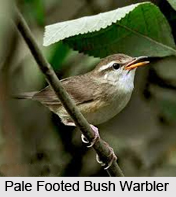 Pale-Footed Bush Warbler is an Indian Bird that bears a scientific name "Urosphena pallidipes" concentrated in South Asian countries. Pale-Footed Bush Warbler is a resident bird for Nepal. It is mostly found in Chitwan. This species as well as other species of the birds in Nepal are threatened due to habitat loss and population decline in Nepal. The global population size of Pale-Footed Bush Warbler has not been quantified, but the Pale-Footed Bush Warbler is reported to be fairly common and locally abundant in the regions of Nepal, Bhutan, Sikkim, Himachal Pradesh and Jammu and Kashmir
Pale-Footed Bush Warbler is an Indian Bird that bears a scientific name "Urosphena pallidipes" concentrated in South Asian countries. Pale-Footed Bush Warbler is a resident bird for Nepal. It is mostly found in Chitwan. This species as well as other species of the birds in Nepal are threatened due to habitat loss and population decline in Nepal. The global population size of Pale-Footed Bush Warbler has not been quantified, but the Pale-Footed Bush Warbler is reported to be fairly common and locally abundant in the regions of Nepal, Bhutan, Sikkim, Himachal Pradesh and Jammu and Kashmir
Category of Pale-Footed Bush Warbler
Pale-Footed Bush Warbler is a species of warbler in the family of Cettiidae, found in South Asia. It is known as Oriental bird.
Species of Pale-Footed Bush Warbler
There are three subspecies of Pale-Footed Bush Warbler that are pallidipes, osmastoni and laurentei.
Concentration of Pale-Footed Bush Warbler
Pale-Footed Bush Warbler is found in the Himalayan Mountain Range region west from Deharadun through the foothills of Nepal to the Northeast India. This species is further found in Myanmar, Laos, northern Vietnam and southern China.
Behaviour of Pale-Footed Bush Warbler
Pale-Footed Bush Warbler is extremely shy and is a great skulker, meaning it is very difficult to see even during the breeding season.
Breeding of Pale-Footed Bush Warbler
Pale-Footed Bush Warbler breeds from May to July. The bird is usually found either by itself or in pairs in low bushes and grass clumps. It is also known as lowland species. It likes to stay close to ground; thus, it flies less than a meter high above ground. It moves through grass reeds keeping it low, staying mostly out of sight.
Feeding of Pale-Footed Bush Warbler
Pale-Footed Bush Warbler feeds on the lower half of grass reeds. The Pale-Footed Bush Warbler has a loud song. Because Pale-Footed Bush Warbler stays low part of its habitat, its song and call is easier to be heard than to be seen. This species remains mostly silent during winter but its call and song can be easily heard during spring. Its explosive song is the best way to signal its species.



















